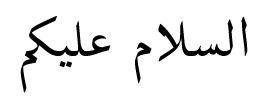 | ||
ArabTeX is a free software package providing support for the Arabic and Hebrew alphabets to TeX and LaTeX. Written by Klaus Lagally, it can take romanized ASCII or native script input to produce quality ligatures for Arabic, Persian, Urdu, Pashto, Sindhi, Shahmukhi Punjabi, Maghribi, Uyghur, Kashmiri, Hebrew, Judeo-Arabic, Ladino and Yiddish. ArabTeX characters are placed within a TeX/LaTeX document using the command \RL{ … } or the environment \begin{RLtext} … \end{RLtext}. ArabTeX is released under the LaTeX Project Public License v1+.
Contents
\novocalize\RL{al-salAm `alaykum}\setarab (set language specific rendering) \setfarsi (set language specific rendering) \setuighur (set language specific rendering) \set... (more language conventions, see the documentation) \novocalize (individual vowel marks can be displayed using "a, "i, "u) \vocalize (individual vowel marks can be cancelled using "a, "i, "u) \fullvocalize (individual vowel marks can be cancelled using "a, "i, "u) \setcode{ } (switch input encodings) \settrans{ } (switch transliteration conventions)
Common commands
Character table
Note that one can also overcome the problem with <yah> containing dots using the following command.
References
ArabTeX Wikipedia(Text) CC BY-SA
